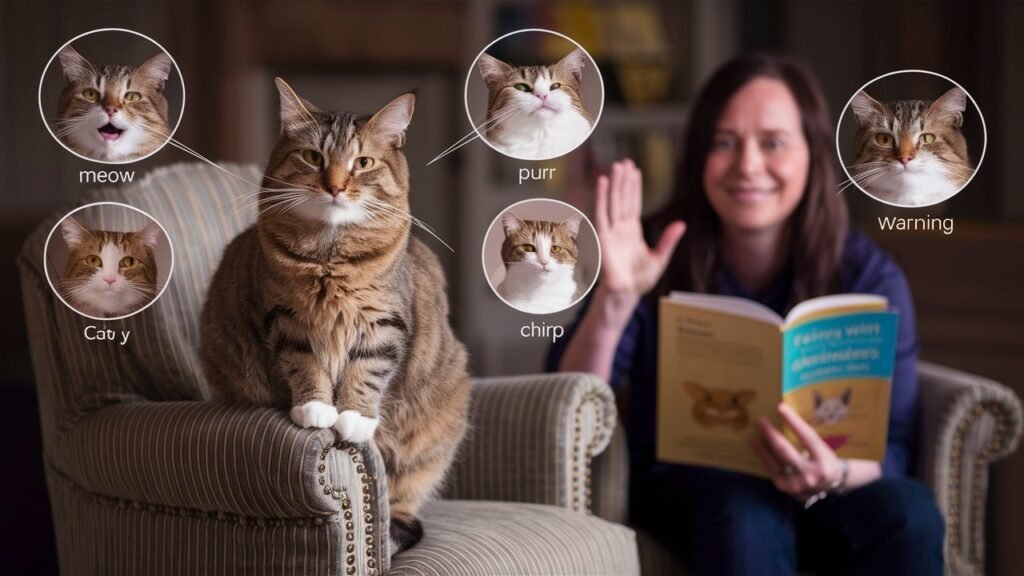Our feline companions may appear aloof and independent, but they are surprisingly communicative creatures. Unlike their canine counterparts who readily express themselves with barks and whines, cats use a rich repertoire of vocalizations to convey their needs, emotions, and desires.
This blog post delves into the fascinating world of feline communication, equipping you with the knowledge to decipher your cat’s unique “meowcabulary.” We’ll explore the common vocalizations cats use, their potential meanings, and how to interpret them in context.
Beyond the Meow: A Cat’s Vocal Repertoire
While meows are the most well-known feline vocalization, cats have a surprisingly wide range of sounds at their disposal.
Here’s a breakdown of some common cat vocalizations:
- Meows: The classic meow can have a variety of meanings depending on the pitch, length, and context.
- Purrs: Often associated with contentment, purring can also indicate other emotions like seeking attention or feeling unwell.
- Yowls: These loud, drawn-out sounds typically express fear, pain, or aggression.
- Hisses: Hissing is a clear warning sign that your cat feels threatened and wants something to back away.
- Trills: High-pitched trills can indicate excitement or greeting, especially between kittens and their mothers.
- Chattering: Rapid chattering sounds often occur when a cat sees prey, like a bird outside the window.
- Chirps: Short, high-pitched chirps can be a greeting or an invitation to play.
Table: Dealing with Cat Vocalizations: Interpreting Meows, Purrs, and Other Sounds
| Vocalization | Possible Meanings | Context Clues |
| Short meow | Greeting, hello, attention seeking |
Cat makes eye contact, rubs against your legs, or follows you around.
|
| Long meow | Hunger, wanting something |
Occurs around mealtimes, near empty food bowls, or when cabinets open.
|
| Insistent meow | Urgent need, distress |
Cat’s meow becomes more insistent or frantic, accompanied by pacing.
|
| High-pitched meow | Excitement, greeting, playfulness |
Cat rubs against you, arches its back, or bats at toys playfully.
|
| Low-pitched meow | Discontent, complaint |
Cat appears withdrawn, ears flattened, or tail tucked between legs.
|
| Purr | Contentment, relaxation, seeking attention |
Cat curls up on your lap, rubs against you, or closes its eyes contentedly.
|
| Yowl | Fear, pain, aggression |
Cat appears scared, hisses, or tries to hide or escape.
|
| Hiss | Warning, feeling threatened |
Cat arches its back, flattens its ears, and may swipe with its paw.
|
| Trill | Excitement, greeting (kittens) |
Cat approaches with a raised tail, rubs against you, or looks playful.
|
| Chatter | Hunting instinct, seeing prey |
Cat focuses intently on something outside, like a bird.
|
| Chirp | Greeting, invitation to play |
Cat approaches you with a raised tail, rubs against your legs, or bats at toys.
|
Remember: This table provides a general overview. It’s important to consider all the body language cues and the situation to interpret your cat’s vocalizations accurately.
Putting it All Together: Interpreting Vocalizations in Context
A single meow or purr doesn’t always tell the whole story. Here are some tips for interpreting your cat’s vocalizations in context:
- Body language: Pay attention to your cat’s posture, facial expressions, and tail position. These cues can provide valuable insights into their emotional state.
- Time of day: Certain vocalizations may be more frequent at specific times. For example, a persistent meow around mealtimes likely indicates hunger.
- Recent events: Consider if anything has changed in your cat’s routine or environment that might be causing them distress.
- Know your cat: Every cat has its own unique personality and communication style. Over time, you’ll learn the nuances of your cat’s vocalizations.
Building a Stronger Bond with Your Feline Friend
By understanding your cat’s vocalizations, you can not only improve communication but also strengthen the bond you share. Here are some ways to put your newfound knowledge into action:
- Address underlying issues: If your cat’s vocalizations seem excessive or persistent, consult your veterinarian to rule out any medical conditions that might be causing them discomfort.
- Environmental enrichment: Provide your cat with plenty of mental and physical stimulation through toys, scratching posts, climbing structures, and perches to gaze out the window. This can help reduce boredom-related vocalizations.
- Respect their boundaries: Not all meows are requests for attention. If your cat seems stressed or wants to be left alone, respect their wishes and give them some space.
- Positive reinforcement: When your cat vocalizes in a desired way (e.g., a friendly chirp), reward them with petting, treats, or playtime. This will encourage them to repeat the positive behavior.
Conclusion: Unlocking the Secrets of Feline Communication
Understanding your cat’s vocalizations opens a door to a deeper level of communication and strengthens the bond you share. By learning to “speak meow,” you can create a more enriching environment, provide them with the care they need, and build a lifelong friendship based on mutual respect and understanding. Remember, patience, observation, and a willingness to learn are key to unlocking the secrets of feline communication.
So, the next time your cat lets out a meow or a purr, take a moment to decipher the message. You might be surprised by what they have to say!

